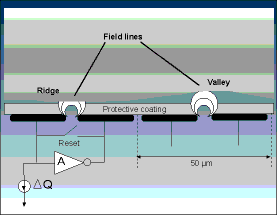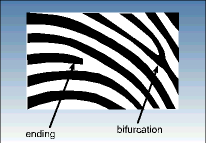
One of the most important parts of security is authentication. To ensure a person’s real identification is a critical task in many situations. Common methods like passports, ID cards or signatures proved to be insufficient in important cases, as they can be lost or stolen, misused or tampered. It is time to look for some new methods, which will be unique and reliable.
Biometric authentication
One answer for this need is biometric authentication, based on measuring of human body characteristics. These characteristics must carry out strict demands on uniqueness and invariability. Basically these characteristics can be divided into two groups - behavioural and physiological. The behavioural characteristics include for example voice recognition, keystroke style or handwritten signature recognition, while the group of physiological characteristics include methods like fingerprint recognition, hand geometry, face recognition or iris and retina scanning. Modern trends orientate more to the physiological characteristics, as the behavioural ones are found to be varying in dependency to a person's disposition (ie your voice changes when you are ill or getting upset).
There are many parts of a human body, which were proven to be unique to each person. One important part of the human body is a hand. Biometric characteristics here start with hand geometry and vein topology. Finally, getting to the fingers, one rediscovers the old known truth, that fingerprints can uniquely verify the person's identity. This fact has been utilised since the 1920s in criminology.
Complex science
Biometry is a complex science which implements many modern, sophisticated technologies. Depending on the measured characteristic one may employ the functionality of a voice recorder, picture scanner, video camera or even specialised medical instruments for blood analysis (DNA recognition). When an existing technology is being used it needs to be adapted for the special demands of measuring the selected biometrics. However, there are already new technologies developed especially for particular biometric measuring. An example can be found in the fingerprint scanning technology, where an optical sensor is an adapted CCD or CMOS element, while a silicon sensor is bringing a specialised new technology.
Capacitive fingerprint scanning
Capacitive fingerprint scanners are based on silicon plate, which contains a field of small, tiny capacitors. They are situated evenly in a square or rectangular matrix. Generally the rectangular sensors are considered as more suitable because they better fit the shape of a human fingerprint, which is not square. Also, the larger is the area on which the fingerprint image is read, the more information can be obtained. A protective coating usually specially developed and patented by the fingerprint sensor manufacturer covers the silicon field itself. It must be a very hard and resistant layer to protect the silicon circuits, but still it must be as thin as possible to let the finger come very close. Some vendors prove quality of their coating by publishing test results for surviving more than one million touches.
And how can these capacitors read the ridges and valleys of a fingerprint? There are actually two approaches - passive and active scanning. Both of them are based on charging and discharging the capacitor field and reading back the values affected by the distance of the finger skin at each particular point.
However, one possible disadvantage can be the sensor's vulnerability to damage by ESD (electrostatic discharge). ESD can be harmful for any silicon component. Usually a thick layer of plastic is solving this issue by covering the silicon, but the fingerprint sensor can be covered only by the ultra thin coating and the silicon stays exposed. In order to lead the discharge out of the silicon, additional techniques must be implemented such as grounding grids or holes. In today's sensors this technology is so advanced that fingerprint scanners are able to withstand electrostatic discharges above the value of 15 kV.
Touching the silicon almost directly brings an advantage, as it is possible to easily implement additional sensing features, which are needed to recognise a real, live fingerprint from a fake or dead one. There are more characteristics of the live fingerprint, which can be measured (eg temperature, blood pressure or pulse and so on). By combining more of these measures we are getting to a more secure (spoof resistant) fingerprint scanner. Hardware capabilities together with their software support delimit the anti-spoofing features of the scanner.
Passive scanning principle
In passive silicon scanners you can only find one plate of each capacitor. Fingerprint being scanned then represents the other plate. Scanning happens in two phases, in the first phase the capacitors are pre-charged (usually one row at a time), and there are so called sample-and-hold circuits, which can store the pre-charged plate voltages. In the second phase, the row of sensor plates is discharged with a current source and a second set of sample-and-hold circuits store the final value. The difference between the stored pre-charged and discharged plate voltages is a measure of the capacitance of a sensor cell. After the row capture, the cells within the row are ready to be digitised. The whole image of the fingerprint is scanned row by row. This row access limits the need of sample-and-hold circuits to just two for each column.
The above described scanner can adjust the values of precharging and discharging current as well as the delay time between the phases in order to be able to read fingers under different conditions (sweating, dry fingers and so on).
Active scanning principle
Sensor cell contains both plates of the capacitor connected to an active capacitive feedback circuit through an inverter (inverting amplifier) creating a charge integrator: one plate is connected to the inverter input and the other plate is connected to the inverter output (see Figure 1). Function of the charge integrator is to convert the feedback capacitance to an output voltage, which can be already digitised.

Active sensor works also in two phases. In the first phase the reset switch shortens the inverter's input and output in order to settle on an initial value. In the second phase the reset switch is opened and a calibrated charge is used for charging the capacitor plate, which is connected to the integrator input. An electromagnetic field is generated between the capacitor plates. The skin of the fingerprint interferes with the electromagnetic field causing change of the effective capacitance. Depending on the presence of the fingerprint ridge or valley, the feedback capacitance is minimised or maximised respectively. Resulting feedback capacitance is then digitised.
As each of the sensor's cells has its own charge integrator circuit, the picture pixels can be addressed in a random-access mode enabling advanced functions such as windowing (scans only selected area of the image) and sub sampling (gets a lower resolution image more quickly).
Active scanning technology provides much higher immunity to parasitic effects.
Fingerprint image processing and matching
Usual methods for fingerprint recognition are pattern based and minutia based recognition. Some systems even combine both of them. Pattern recognition stores selected parts of the fingerprint image. Then the matching algorithm tries to find the same areas both in the stored template and the template extracted from the fingerprint just entered for authentication. Template size is around 1000 bytes.
Minutia based recognition extracts from the image just particular points, where a feature (called minutia) is found, usually a ridge ending or bifurcation (Figure 2). Relative positions of the minutia and often also orientation of the ridge involved are then the content of the fingerprint template. Matching algorithm then looks for the same mutually positioned features. Fingerprint rotation and translation does not affect the matching algorithm, as it is working with relative measures. In this case the template size shrinks to some 300 bytes. Processing this small amount of data is possible even on systems with processor speed and memory limitations.

Matching algorithms and benchmarking
There are many minutia-based matching algorithms on the market. Let us talk a little bit about what are the criteria for considering their quality.
It is important is to realise that matching algorithm characteristics are very much dependent on a fingerprint database used for the algorithm testing (ie benchmarking). One can get very good results even with a poor algorithm if only higher quality fingerprints are selected for the test. In the same manner, some good algorithms can give worse results on a database containing poor quality fingerprints. Therefore, matching algorithm comparisons can only be done when the same database is used for them all.
Algorithm tests are called benchmarking. For getting useful and realistic results it is needed to use as large as possible fingerprint database (at least thousands of people), which was collected in different world locations from people of various races, ages and occupations and under different conditions (humidity, temperature and others).
Future - integrated module
Fingerprint recognition has many indisputable advantages and this is a reason why it is being implemented into more and more applications. Already today there are notebooks, PDAs, door locks, ATMs and various computer peripheries with integrated fingerprint sensors. Further development decreases size and cost of the sensors, which opens doors for many other applications - for example mobile phones, POS terminals or automotive appliances.
The target of the future development is to integrate the fingerprint sensor with powerful microprocessor and memory. This will create a secure authentication module capable of doing the whole recognition task from sensing to matching with no additional hardware needed.

© Technews Publishing (Pty) Ltd. | All Rights Reserved.